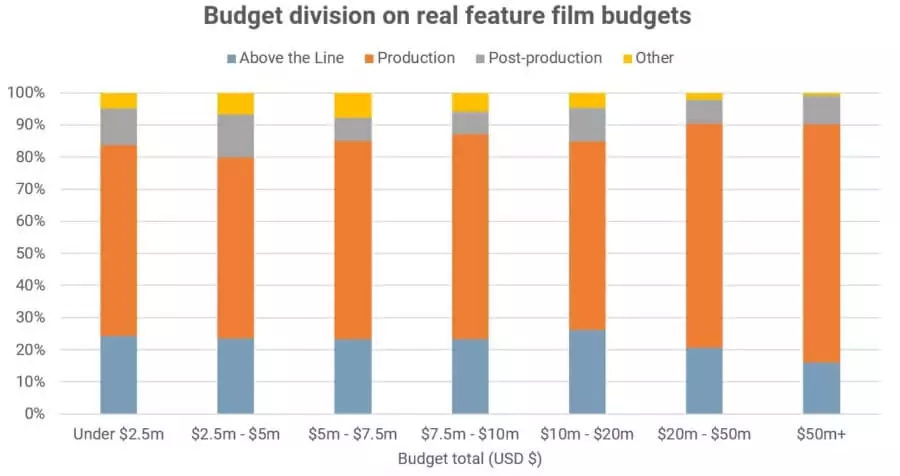If you are at all interested in the behind-the-scenes side of filmmaking, then you may have heard the terms “above the line” and “below the line” thrown around in interviews, articles, or BTS footage. In this article, we’ll be discussing above and below the line in film and breaking down exactly what above the line credits are, where the term “above the line budget” comes from, and we’ll be listing all of the above the line positions.
Above the line meaning
What does above the line mean?
The terms ‘above the line,’ ‘above the line budget,’ or ‘above the line personnel’ can mean different things in different industries. The terms ‘above the line personnel’ and ‘above the line budget’ also find use in accounting, advertising, and workplace leadership. But in film, above the line has a drastically different meaning. Above and below line in film production, has a specialized meaning.
Above the line can actually mean two related but slightly different things when applied to filmmaking. We’ll cover both of these meanings and the differences when talking about above the line vs below the line. Without further ado, let’s lay out an above the line definition.
ABOVE THE LINE DEFINITION
What is above the line?
Above the line in film production refers to the costs of making a movie associated with the major creative talent. Above the line credits include the director, actors, writers, and producers. Films with special effects will also have a greater number of above the line personnel and costs than films without special effects.
In addition to its budgetary relationship, above the line also denotes the roles on a film crew which provide guidance or leadership on the creative side. Likewise, below the line represents the more technical roles.
Above the Line Definition Summary:
- Monetary distinction between creative and technical roles
- Above the line positions denote certain roles on a film crew
- Above the line credits are standard across most productions
If there above the line personnel, there must be below the line personnel, right? To learn more about the corresponding term and the differences of below the line vs above the line, read on with What Does Below the Line Mean?
If you encounter any unfamiliar terms throughout this article, you can continue your filmic education by looking them up in our Ultimate Glossary of Filmmaking Terms. And since we'll be discussing the various filmmaking jobs, you might also benefit from our guide to Film Crew Positions.
Above the line vs below the line
Why divide above and below the line?
The term itself comes directly from budgeting. Film-production budget sheets are divided into two sections by a line. This budgetary line is where crew members are placed either above or below.
Film crew members above the line are what is known as ‘fixed rate,’ meaning their pay is set and agreed upon before production begins and does not change based on alterations to the production schedule, while the same cannot be said of crew members below the line. Above the line credits are given to those who are considered essential crew, whereas below the line crew members are considered “replaceable.”
The major distinction between above the line vs below the line is budgetary. For a quick and easy-to-follow breakdown of film set hierarchy amongst above and below the line personnel, check out the video below.
5 Minute Film School breaks down film crew hierarchy
The term ‘above the line’ may have been born as a purely financial designator, but these days the term is also commonly used for matters outside of monetary concerns. Beyond budgetary implications, being above the line crew also indicates a level of importance, and of creative influence. Below the line crew members can be swapped out part way through a production, e.g. a PA working for just a couple of days on set, or a grip involved in only part of a production.
Meanwhile, the above-the-line crew almost always remains consistent for the duration of a film shoot, unless major friction develops and leads to someone quitting or being fired by the producer or studio.
above the line positions
Which positions are above the line?
Only a handful of positions on a film crew are considered above the line, while the majority remain below the line. Above the line roles typically include:
- Producers
- Directors
- Screenwriters
- Principal Actors
Check out our “Making It” series to see how above and below the line crew members work together on a production.
Episode 1 of our 6-part series • Subscribe on YouTube
It is possible for a particular production to divide their above and below the roles up in a different manner, but these four film roles are considered the standard above-the-line stock.

Budget Division for Feature Films
You’ll notice some major film positions are not included above the line. You may have expected to find important personnel such as the director of photography, editor, and production designer above the line, but these roles are actually considered below the line by this traditional metric.
The reason for this is two-fold. First, their pay is considered variable, hence the budgetary designation as below the line. And second, the DP and production designer are considered technical roles rather than creative ones. There is a significant degree of creativity involved in their work, but those creative decisions are not ultimately their responsibility to make, but rather the director’s. They help deliver the director’s vision rather than shaping the creative side of a film directly. The budgetary distinction becomes less important when working on a zero-budget film.
To learn how a line producer keeps above and below the line costs in mind while budgeting, check out our video on the key role of line producers.
A line producer’s #1 duty explained
The line producer’s job can get a little bit easier if they use our free budget template. Organizing and managing a film crew, both above and below the line, can be tricky but it gets a whole lot easier when you use StudioBinder’s Film Crew Management Software. Get started today for free.
UP NEXT
Who works below the line?
Now that you know what above the line means, it is the perfect time to read up on below the line too. Understanding the distinctions between above the line and below the line are key when budgeting or undertaking any sort of crew management.
